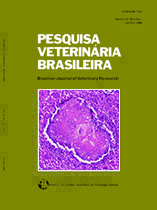 |
|
|
|
Year 2017 - Volume 37, Number 11
|

|
Equine multinodular pulmonary fibrosis in southern Brazil: pathology and differential diagnosis, 37(11):1247-1252
|
ABSTRACT.- Estima-Silva P., Marcolongo-Pereira C., Santos B.L., Coelho A.C.B., Amaral L.A., Lim A., Bolin S.R. & Schild A.L. 2017. Equine multinodular pulmonary fibrosis in southern Brazil: pathology and differential diagnosis. Pesquisa Veterinária Brasileira 37(11):1247-1252. Laboratório Regional de Diagnóstico, Faculdade de Veterinária, Universidade Federal de Pelotas, Campus Universitário s/n, Pelotas, RS 96010-900, Brazil. E-mail: alschild@terra.com.br
Equine multinodular pulmonary fibrosis (EMPF) diagnosed at the Laboratório Regional de Diagnóstico of Faculdade de Medicina Veterinária, Universidade Federal de Pelotas (LRD/UFPel), is described. Differential aspects of other pulmonary diseases in horses with pneumonia and interstitial fibrosis were discussed. The disease occurred in a 15-year-old equine that presented with clinical signs of respiratory distress, intermittent fever, anorexia, and dyspnea. Macroscopically, there was enlargement of the lungs with whitish, pale, firm and well-delimited nodules, approximately 7-10 cm in diameter, distributed throughout the parenchyma. Histologically, the lung nodules had alveolar spaces with walls covered by cuboidal epithelium containing macrophages, neutrophils, lymphocytes, hyperplasia of type II pneumocytes and, eventually, multinucleated giant cells. The interstitium was markedly thickened by mature fibrous connective tissue and collagen. There were intranuclear inclusion bodies in the macrophages. The PCR technique for detecting the EHV-5 DNA was positive. In a retrospective study of pneumonia cases in horses with interstitial fibrosis diagnosed in the LRD/UFPel, two animals had macroscopic and histological lesions similar to those with EMPF, but they were negative for EHV-5 in PCR. Four cases diagnosed with pneumonia and interstitial tissue fibrosis had a histological pattern that was different from that observed in the EMPF animal, thus eliminating the possibility of EMPF. It is concluded that EMPF is a sporadic disease that should be considered in cases of respiratory disease in horses. Reports of such cases are important to alert technicians about the occurrence of rare diseases in Brazil. It is also necessary to establish the true role of EHV-5 in the pathogenesis of EMPF. Cases of pulmonary fibrosis such as EMPF, in which the virus is not present, should be studied to establish whether it could be an idiopathic form of the disease. |
| |
|
|
| |
|
 |